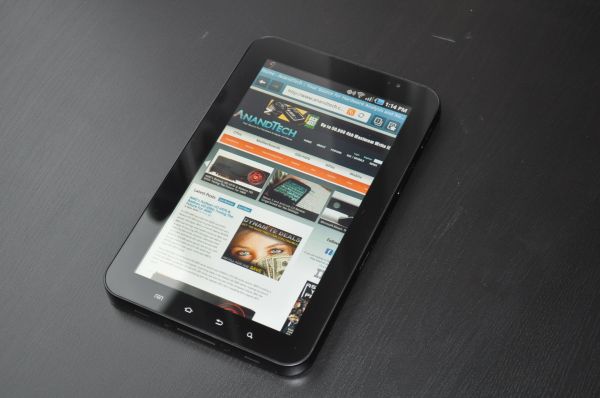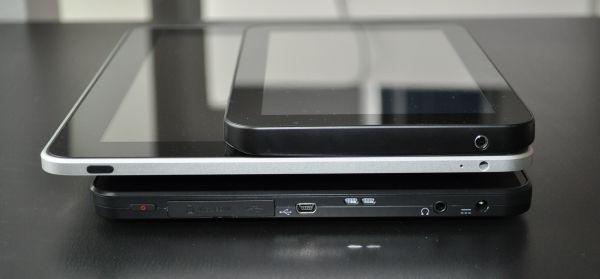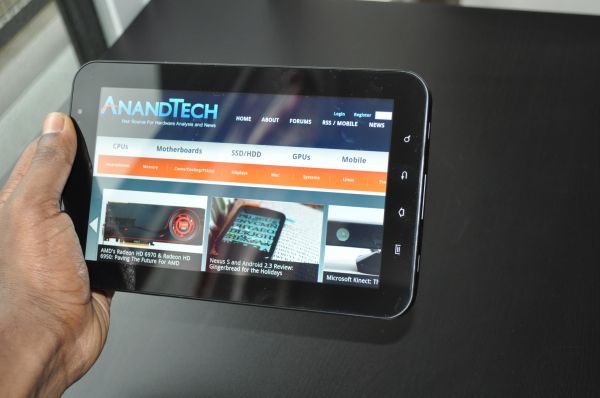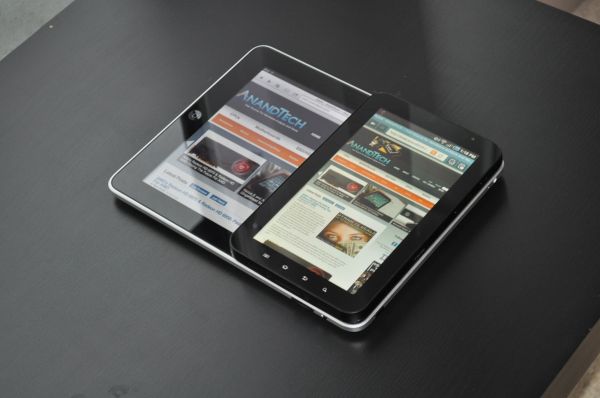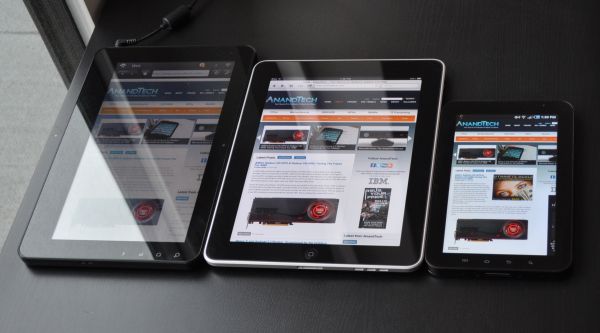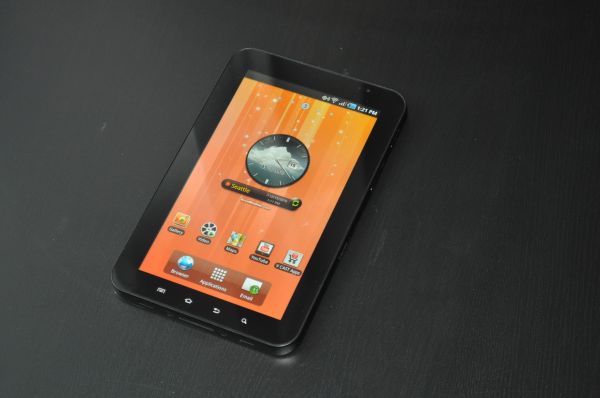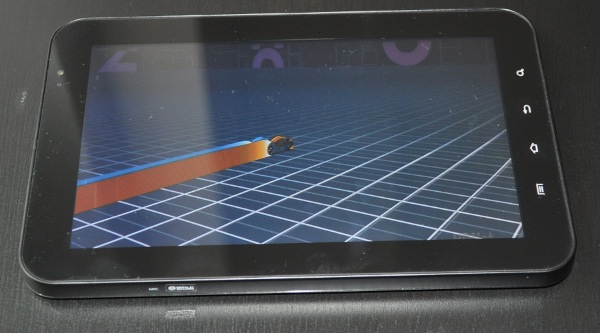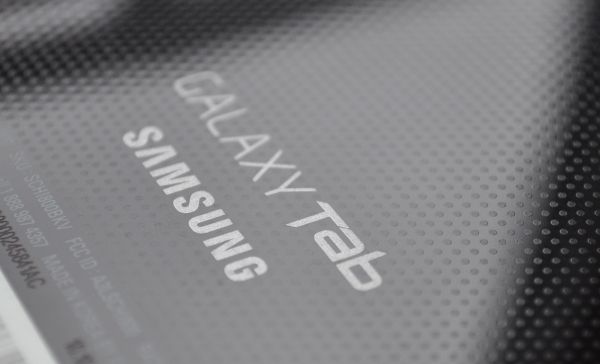
Original Link: https://www.anandtech.com/show/4062/samsung-galaxy-tab-the-anandtech-review
Samsung Galaxy Tab - The AnandTech Review
by Vivek Gowri on December 23, 2010 9:48 AM ESTThe iPad started shipping in April, and since then it has basically had the tablet market to itself. Literally, in the six months after the iPad’s release, it didn’t have a single direct competitor. Dell launched the Streak shortly after the iPad, but the Streak was a 5” unit that was significantly smaller than the iPad. In the 7-11” tablet market, Apple has been the only real player.
But that all changed when Samsung launched its 7” Galaxy Tab last month. It’s available for $599 off contract on all four major American carriers and US Cellular ($399 on a two year contract with Sprint or US Cellular, $349 for T-Mobile), with a $499 WiFi-only model on the way. If those pricepoints sound familiar, it’s because the unsubsidized prices are right on top of the 16GB iPad. I’m betting that’s not coincidental; it’s pretty clear what Samsung was targeting when they priced the Tab.
The Tab is the first Android slate to come from a major manufacturer, and probably will be the last one to release with Froyo. The rest (Dell’s 7” Looking Glass tablet, the Motorola tablet showed off in Google’s D: Dive Into Mobile press conference, and rumored devices from HTC, Acer, Asus, and others) appear to be releasing with Honeycomb in the early part of next year. Samsung says that the Galaxy Tab will be updated to Gingerbread at some point in the future, along with Honeycomb whenever that releases. But we’ll get to the software in a moment, let’s talk hardware first.
| Samsung Galaxy Tab Physical Comparison | |||||||||
| Samsung Galaxy Tab | Apple iPad | Motorola Droid X | HTC EVO 4G | Samsung Galaxy S Fascinate | |||||
| Height | 190.1 mm (7.48") | 248.2 mm (9.6") | 127.5 mm (5.02") | 121.9 mm (4.8") | 125 mm (4.92") | ||||
| Width | 120.5 mm (4.74") | 189.7 mm (7.5") | 66.5 mm (2.62") | 66.0 mm (2.6") | 63.5 mm (2.5") | ||||
| Depth | 12.0 mm ( 0.47") | 13.4 mm (0.5") | 9.9 mm (0.39") | 12.7 mm (0.5") | 9.91 mm (0.39") | ||||
| Weight | 380 g (13.4 oz) | 680 g (24.0 oz) | 155 g (5.47 oz) | 170 g (6.9 oz) | 117 grams (4.16 oz) | ||||
| CPU | 1 GHz Samsung Hummingbird | Apple A4 @ 1GHz | TI OMAP 3630 @ 1GHz | Qualcomm Scorpion @ 1GHz | 1 GHz Samsung Hummingbird | ||||
| GPU | PowerVR SGX 540 | PowerVR SGX 535 | PowerVR SGX 530 | Adreno 200 | PowerVR SGX 540 | ||||
| RAM | 512MB LPDDR1 | 256MB LPDDR1 | 512MB LPDDR1 | 512 MB LPDDR1 | 512 MB LPDDR1 | ||||
| NAND | 16GB or 32GB integrated | 16GB integrated | 8GB micro SD | 8GB micro SD | 2 GB, 16 GB microSD (Class 2) | ||||
| Camera | 3.2MP with LED Flash + Front Facing Camera | None | 8MP with dual LED Flash | 8MP with dual LED Flash + Front Facing Camera | 5 MP with auto focus and LED flash | ||||
| Screen | 7.0" 1024 x 600 LCD | 9.7" 1024 x 768 IPS | 4.3" 480 x 854 | 4.3" 480 x 800 | 4. 0" 800 x 480 Super AMOLED | ||||
| Battery | Integrated 14.8Whr | Integrated 25 Whr | Removable 5.698 Whr | Removable 5.5Whr | Removable 5.55 Whr | ||||
On paper, the Galaxy Tab is essentially a jumbo-sized implementation of the Galaxy S smartphone platform. You’re looking at the same A8-based 1 GHz Hummingbird processor and PowerVR SGX 540 graphics chip, the same 512MB RAM, the same lightweight plastic build, and pretty similar industrial design. The screen has been upsized, from the 4” WVGA unit in the Galaxy S to a 7” WSVGA panel, but it’s not a Super AMOLED display like on the smartphones. You lose a couple of megapixels and HD video recording capability on the rear-facing camera, but the Galaxy Tab does get a 1.3MP front facing camera for video calling.
The design is rather minimalistic, with the front having a small bezel around the screen and four capacitive touch buttons underneath the screen. Since we’re on the topic, I’d like to voice my annoyance that the touch buttons are always in different orders. HTC and Samsung use different layouts, Motorola uses two different layouts for no explicable reason, and Google has specced both of its Nexus phones with layouts that are not normally used by their manufacturers. The lack of standardization isn’t a huge problem, but it can get annoying if you switch between multiple Android devices on a daily basis.
The top view of the Galaxy Tab, iPad, and Vewsonic G Tablet (top-bottom)
Anyways, back to the industrial design. The sides are matte black, with the headphone jack at the top, dock connector and speakers at the bottom, mic on the left side, and the power and volume buttons and the covered microSD card slot on the right side. The back is glossy and dotted in the same way as the Fascinate and Vibrant. Unfortunately, the Galaxy Tab’s back panel is non-removable, so you can’t swap out the battery. Compared to the iPad, the overall feel is a bit less high end, mostly due to the use of glossy plastic instead of the aluminum unibody. But overall, the ID is very straightforward, leading to a clean and elegant device.
When you pick it up, the Galaxy Tab feels light, almost shockingly so. Given that it’s half the size of the iPad and just over half the weight, this first impression isn’t exactly unfounded. Given the lightness, the feeling of solidity is actually surprising if you’re expecting something along the lines of the Galaxy S phones - compared to the ultralight Fascinate/Captivate/Vibrant/Focus, the Tab feels significantly more substantial. The overall build quality definitely exceeded my expectations, though the unibody aluminum shell puts the iPad on a different level.
Samsung Galaxy Tab - Oh, That Screen
Really, I have to commend Samsung here. There’s no AMOLED, no IPS, and no S-LCD, but they managed to put a very high quality LED-backlit LCD panel into the Galaxy Tab. The contrast ratio is a devilish 666:1, neatly splitting the difference between the EVO 4G and the Dell Streak, but well short of the iPad’s stellar 934:1 number. But the best thing about the screen is that even without any of the more advanced display technologies, viewing angles are still excellent. As we’ve mentioned before, viewing angles are significantly more important for tablets than netbooks or notebooks, so it’s reassuring to see that Samsung recognizes this.
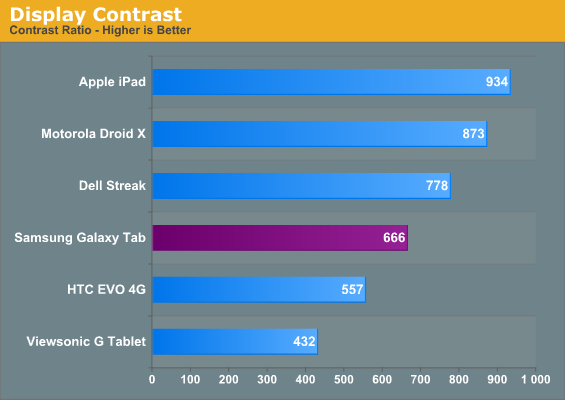
The 7” display packs the same WSVGA resolution as most 10” widescreen tablets, so the pixel density is relatively high at 170ppi (versus 138 for the iPad and 116 for most 10” WSVGA tablets). Current rumors put some of the upcoming 10” tablets at 1366x768 or 1280x800, so we’ll see pixel density rise for the industry as a whole, but overall the Galaxy Tab has a pleasantly crisp screen.
The end user experience of any tablet really begins with the screen, and it’s probably one of the most overlooked components in any given device. The display can really make or break any tablet, so it’s important to note that the Galaxy Tab has a very good one.
Samsung Galaxy Tab - Size Really Does Matter
The Galaxy Tab is almost exactly half the size of the iPad.
So the Galaxy Tab, as one of the first 7” tablets to release, brings up a new concern in the tablet space - how much does screen size change things? This is the first real 7” tablet I’ve played with for any length of time, but my first reaction when I pulled the Galaxy Tab out of the box was “dang, this thing is a lot smaller than I expected”. It’s literally half the size of the 9.7” iPad, dimensionally. It’s interesting to see two supposedly competitive devices have such different form factors, completely at odds with how the notebook market works.
The sizing thing is going to be a big deal for tablets going forward, and I think eventually we’ll see the market split into two or three segments based on size. It looks like some companies are already choosing one camp or the other; Apple appears staunchly in the 10” camp after Steve Jobs ripped on the entire 7” form factor, RIM is going 7” for its PlayBook, Dell started with 5” and are adding 7” and 9” models, HP took the middle road with its 8.9” slate, Samsung is adding a 10” Galaxy Tab early next year. So we’re going to be seeing tons of both 7” and 10” form factors on the market.
So why choose one form factor over the other? They’ll likely have similar internal hardware and the same WSVGA resolution on differently sized screens, so it won’t be on specs, and based on the current device pricing, I don’t expect that to be terribly different either. So, really, it comes down to whichever suits your use cases better.
Three tablets, three screen sizes. Pick your form factor wisely.
Honestly, here’s what I found: it’s more comfortable to use the 7” tablet in portrait mode, whereas it’s easier to use the 10”ers in landscape. This is true for both the 4:3 iPad or any of the 16:9 10” widescreen tablets. Part of it is in the keyboard - the 7” portrait keyboard is just comfortable enough to use with two thumbs, whereas in landscape its a bit too wide. The 10” has the opposite problem - too wide for two thumbs and too narrow for normal typing in portrait mode, but just about perfect with two handed typing in landscape. The difference is that with the 7” tablet, you can use it like a large smartphone, whereas the 10” tablets are more suited for use on a desk or table. The iPad and other 10” tablets are better as standalone netbook replacements, while the 7” Galaxy Tab almost feel like a device that’s meant to be carried in addition to a notebook.
Samsung Galaxy Tab - The Software
To anyone who’s played with a Galaxy S phone recently, or really anything running Android 2.2, the Galaxy Tab’s software should be pretty familiar. And if you hate TouchWiz, you should stop reading right now, because the Galaxy Tab comes preloaded with Samsung’s TouchWiz 3.0. It’s not bad, but after a few months with the G2, it’s hard to go back to a skinned version of Android. The skin works about as well as one could expect; it doesn’t change a whole lot to the core functionality of Android beyond adding a very handy task manager, but adds a nice glossy UI layer over Froyo. I noticed some stuttering in some of the menus and animations, though it didn’t significantly detract from the UX. I don’t know if that’s a fault of TouchWiz or the higher resolution display, but I wasn’t expecting it given the 1GHz Hummingbird inside.
There’s two keyboards - Samsung preloaded Swype in addition to their own keyboard. I’m not much of a Swype guy, though I did try it out on the Tab (it’s an interesting concept, but I’ll stick to typing for now); both keyboards work pretty well. There’s not too much to note here beyond saying again that the 7” form factor made the keyboard perfect to use in portrait mode, whereas in landscape mode it was a bit too wide for comfortable typing.
The familiarity of the OS raises an interesting question - other than the larger screen, what is different here versus a regular Android smartphone? Unfortunately, on the OS side of things, the answer appears to be “not much”. Now, there really wasn’t much that Samsung could do about that - Froyo simply isn’t a tablet-centric OS. That’s what Gingerbread and Honeycomb are for. So until that update, the Galaxy Tab is going to feel like an overgrown Galaxy S.
Not that it’s a bad thing - the iPad’s version of iOS makes it feel like a supersized iPhone, and that hasn’t hurt it one bit as of yet. What made the iPad different were the hundreds of applications designed specifically to exploit the comparatively huge XGA screen. That’s the level that Android tablets are going to have to get to, and in my opinion, they’re not there yet. Not by a long shot. There’s not much in the way of tablet specific apps in the Android Market - I found the New York Times Android Tablet app, a Mediafly beta for Tablets, and Verizon’s VZ Navigator for the Galaxy Tab (which came preinstalled on our review unit). Other than that, not much. Now, NYT’s app is nice, but it’s got nothing on their iPad app, and it’s the only marquee application that has a specific tablet version. Normal smartphone apps scale pretty well, but it’s just not the same.
Samsung bundled the Galaxy Tab with some of their own custom applications that were designed to make use of the tablet form factor. Their email client works well enough, splitting into a dual-pane view in landscape mode and doing its job in general. The calendar app is attractive and well designed, with a two pane view in both landscape and portrait modes to show the calendar as well as any upcoming events. The contacts, gallery, and media apps are all pretty satisfactory, and thankfully Samsung saw fit to preinstall an alarm clock app. (Apple, take note. Apparently people like to wake up on time.)
But as you use it, you can tell that Android just isn’t ready to be used on tablets. It’s not “there” yet, not as far as first-party apps, third-party app support, or overall system polish. Even at launch, bugs and missing functionality notwithstanding, Apple made sure it had all three - they put a lot of thought into optimizing the core applications for tablet use, and until Google does the same and gets third party devs on board, Android just won’t be a very good tablet platform.
Samsung Galaxy Tab - Performance
The Galaxy Tab’s internal hardware feels pretty familiar. As with the Galaxy S phones and the newly launched Nexus S, there’s a Hummingbird chip underhood. Samsung’s proprietary SoC bundles a 1GHz Cortex A8 with Imagination’s PowerVR SGX540 GPU and 512MB of LPDDR1.
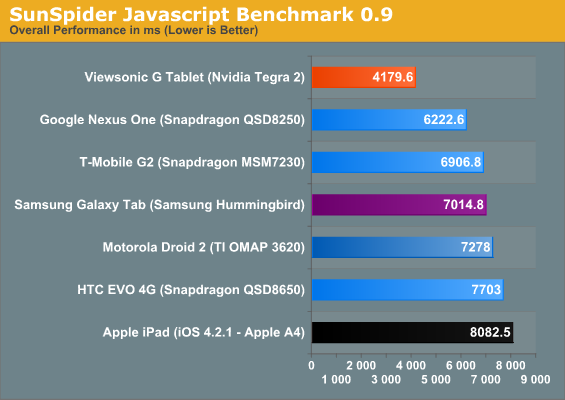
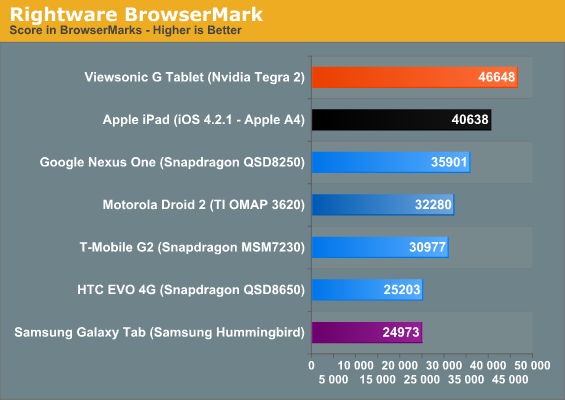
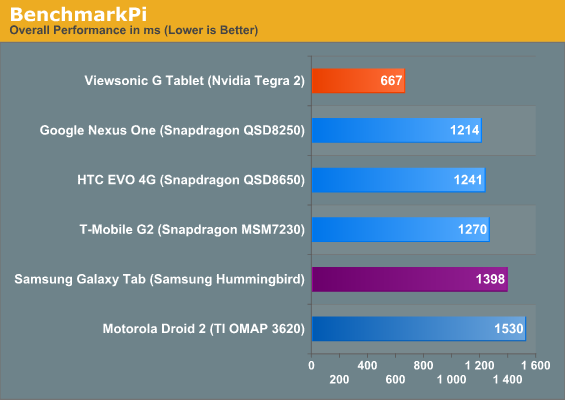
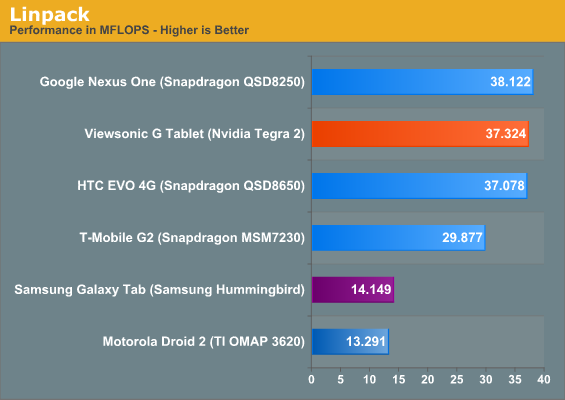
Performance is about expected, given how the Galaxy S devices performed. The second generation 45nm Snapdragon chips are really nipping at the heels of Hummingbird, even surpassing it on the CPU side in our benchmarks. Snapdragon has always had strong FPU performance so the Linpack score is expected, but in SunSpider’s JavaScript benchmark, we see the 1GHz myTouch 4G basically beat everything this side of the Cortex A9/Tegra 2 combo. We talked more about how A9 compared to A8 in our Tegra 2 performance preview here, so look at that to see how the Galaxy Tab stacks up against the tablet platform of the future.
On the graphics benchmark side, we only have two tablets to compare head to head - the Galaxy Tab and the Viewsonic G Tablet that we used in the Tegra 2 preview. The Galaxy Tab handily won out in Neocore - the 54 fps figure is basically capped by the vsync - but the Tegra 2 exhibited slightly faster performance throughout the rest of our smartphone graphics benchmarks. We initially had some issues with Quake 3 on the Tab, as detailed in our Tegra 2 performance update, but overall, SGX 540 is definitely competitive as far as graphics performance goes even if it isn't the clear cut leader anymore.
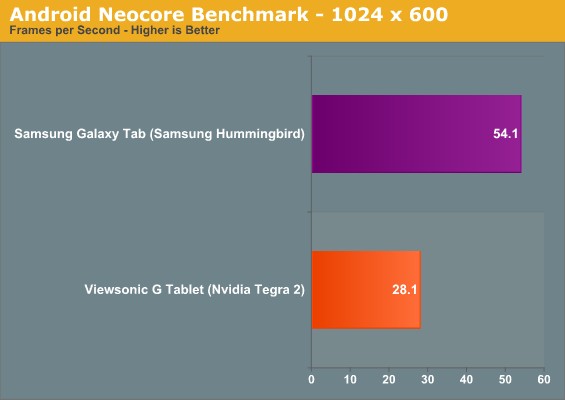
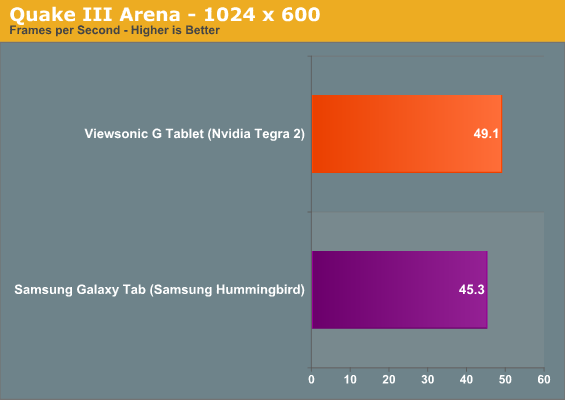
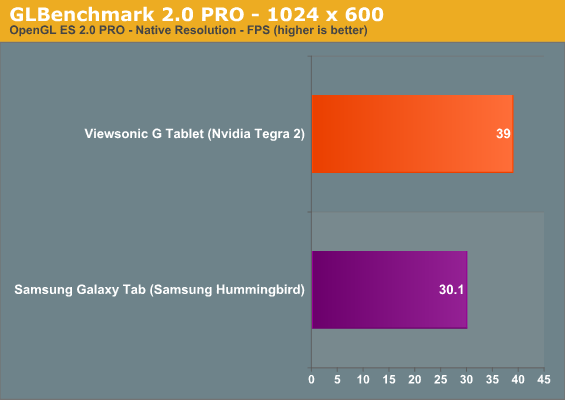
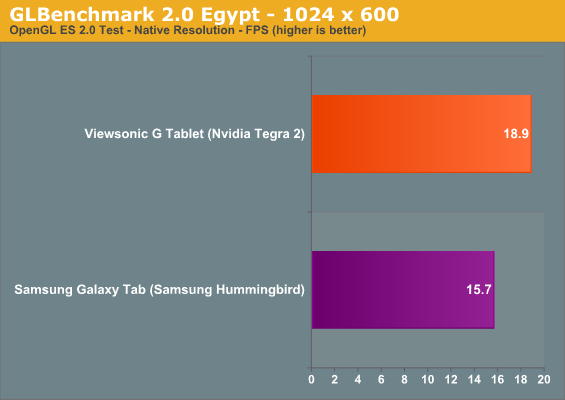
Our Galaxy Tab unit was a Verizon model, but for some reason the 3G data was very slow. I’ve tested it in multiple regions in the Seattle area and I have yet to break 700 kbps down and 500 kbps up. I haven’t had a Verizon device to test before, but even so, speeds around 600 kbps are not what I was expecting. I later talked to some Verizon employees and was told that such speeds are normal for Verizon 3G in Seattle, so their LTE rollout really can't happen fast enough.
Samsung Galaxy Tab - Camera Performance
The Galaxy Tab comes with two cameras - a rather pedestrian 3.2 megapixel rear shooter and a VGA front facing camera. On the good side, this is two more cameras than the iPad. On the bad side, both are pretty mediocre.
Let me explain. The rear camera fares reasonably well in outdoor lighting and indoor areas with lots of natural light, and compressed to web resolutions they look great. Look at the native resolution photos and you’ll see a lot of fuzziness. Things get even worse when you start shooting purely on artificial light - there’s a lot of visible noise even at web resolutions, and the pictures are painful to look at up close. For a midrange phone camera, that’s about as expected, but I wish that Samsung would have spent a little bit more and given the Galaxy Tab a higher end camera.
Outdoor shot taken at 1:45pm in an Audi dealership parking lot. Note the brand new A8.
Indoor shot taken in my extremely messy house. Note the grainy quality, also seen in some of the other indoor shots.
Your humble narrator, taken with the self potrait camera.
The front facing camera has the same issues with indoor lighting, but otherwise functions normally for video calling and “Facebook profile” self-portraits.
HD video recording is sadly not supported, the Galaxy Tab only shoots at 720 x 480. However, the video is actually pretty decent quality, as you can see in the sample below. No re-encoding, just a straight upload to YouTube.
Samsung Galaxy Tab - Battery Life
So the battery life test is an interesting one, in that we don’t have a comparable tablet result yet - Anand used a modified version of the battery test in his iPad review and I haven’t yet had a chance to run the Viewsonic through the battery testing yet. I’m running these tests on my iPad, so I’ll update this page as those results come in.
But overall, the battery life is pretty good. The Galaxy Tab’s 14.8 Wh (4000 mAh) battery managed 9.75 hours on our web browsing test over WiFi. That outdoes the Dell Streak by an hour and a half, the Droid X by an hour, and the EVO 4G by two. Unfortunately, here’s the rub: Anand got almost an exact time out of the iPad, but he ran the same test with music playing in the background and email fetching every 15 minutes. I’m still running the web-only battery life test on the iPad, but I can safely say that it should outlast the Galaxy Tab by a decent margin.
Lightcycles. I kid you not.
To get a feel for battery life during video playback, I timed a looping 2GB H.264 encode of the original Tron DVD. The Galaxy Tab made it through four times over before giving up the ghost, good for 6:42 of video playback. This looks pretty poor in comparison to the 13.6 hours Anand got from the iPad in his 720p h.264 battery life test, but that video file was encoded to a lower bitrate, so it isn’t directly comparable. I’ll be rerunning the iPad using the same Tron file that we used this time around, and it’ll be our standardized HD video file for tablet battery testing going forward.
So without focusing too much on direct numbers, there’s only a couple of takeaways. The Galaxy Tab has pretty good battery life, but there’s not really any directly competing 7” devices to compare it with. The Galaxy Tab is more power efficient than the iPad due to the smaller screen, but the iPad has an absolutely massive 25 Wh battery. That’s the mobile equivalent of stacking the deck, so Samsung shouldn’t feel bad for losing out to the iPad on the battery life front.
Samsung Galaxy Tab - Conclusion
Okay, let’s start with the easy conclusion - the Galaxy Tab is the best Android tablet on the market and probably the second best overall to the iPad. With that said, the iPad is still a superior device by far. It’s not a hardware issue; Samsung did a first-class job with the design of the Galaxy Tab. It’s fast, it’s well built, it’s aesthetically pleasing, and the screen is very good. Sasmung has come out of the gate with a benchmark device for 7” tablets going forward.
So what then? It’s the software. Or, to be more specific, Froyo. It’s too similar to a smartphone right now, too much of the same experience repeated on a 200% scale. To avoid that, companies really only have two options - either wait for a more tablet-centric Android 3.0, or skin the hell out of Froyo and optimize the UI for tablet implementations. There’s a reason that Motorola, Dell, and HTC are waiting until Honeycomb to release their respective tablets. And then you have companies like NotionInk, who has completely scrapped Froyo’s UI and come up with something new altogether in “Eden”, their reimagination of Android as it should be for tablets.
I’m guessing Samsung pushed ahead with the Galaxy Tab to get a jump on the Android tablet market at large, and they deserve to be commended for being the first high profile manufacturer to take a step. Unfortunately, they ended up leaving Froyo mostly alone. They added TouchWiz 3.0, but it’s just a glorified version of the skin you’ll find on your friendly, neighborhood Galaxy S phone. The custom mail and calendar apps are simply not enough to make up for an otherwise undistinguished tablet experience. The core Google apps simply are not tablet-ready, so until they are, it’s up to Samsung.
Samsung is definitely trying their hardest, even releasing a Galaxy Tab emulator for the Android SDK. But for now and even the foreseeable future, they’re not going to have the full-blown ecosystem that Apple had specifically for the iPad at launch. Where does this leave the Galaxy Tab? I’ll say that if you can hold off, it’s probably worth waiting to see what the next generation of tablets holds, but for right now, it’s one of the more competent tablets on the market, and as Google and Samsung build a platform around it, it will only continue to improve.

